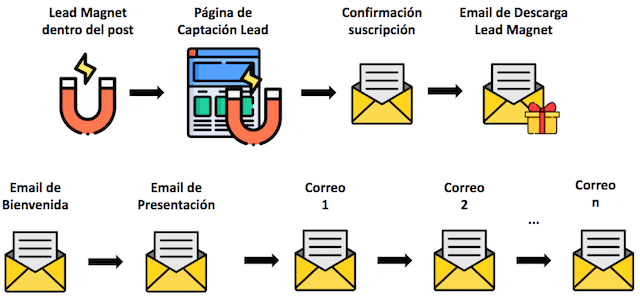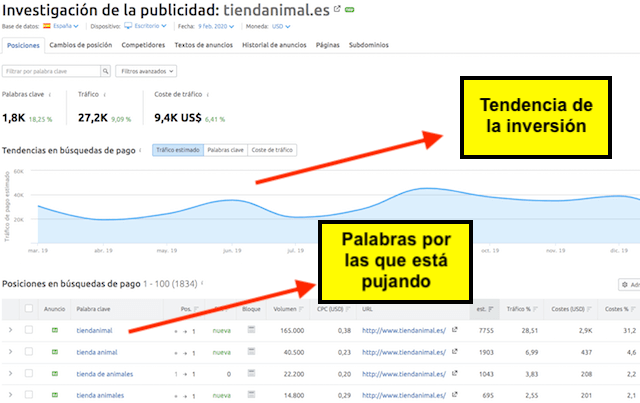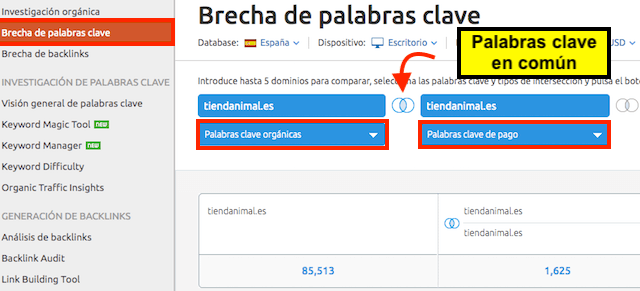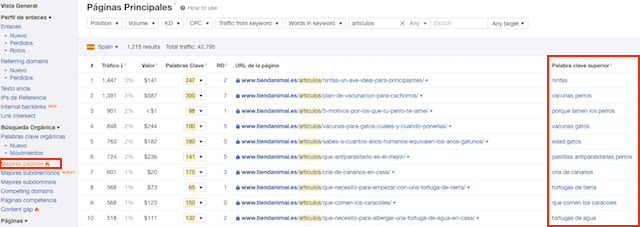When you are going to create a project on the Internet or carry out the digital transformation of a traditional business, it is essential to do a good market study to help us make the best strategic decisions for our project.
Doing a good competitive analysis is not an easy process.
Analyzing data with tools is something that anyone can do, another thing is to interpret this data and obtain valuable information, which is what I am going to teach in this guide.
We are therefore going to become the gadget inspector of the digital world and discover aspects such as:
- What is the business business model of my competition?
- What channels are you using to attract customers and sales?
- What pricing policy are you using?
- How is the sales process and the quality of the product?
- How do you merge your digital strategy with the traditional one?
- What strategies are you using?
Let's go there!!! 😉
You might also be interested in:
What are the potential competitors of a company and how to analyze them [Examples]
Best Digital Marketing Congresses in 2020 [In-person and Online Events]
35 Best Marketing Strategies for Companies [Concept and Examples]
What is competition and what is not?
Let's start with a basic aspect because if you are going to carry out a competition analysis to companies or projects that are not really your real competitors, you are going to lose infinite time, so to have no doubts, keep the following in mind:
exist different types of competition: aspirational, business level competition and keyword level competition.
1) Competition at the business level:
It is one that offers services and / or products very similar to ours, and that the size and community of the brand is also similar.
2) Aspirational competence:
It would be those companies that have a brand and community much superior to ours, that is, how we would like our business to grow in 4 or 5 years from now.
3) Competition at the keyword level:
It is the one that is positioning keywords or keywords related to the same business model.
Therefore, competition would be those companies that have the same business model, the same market and target audience.
If not, they are simply not your competition.
There may also be a Pure or Mixed competition; The pure one is that company that has exactly the same business model and the mixed one that has it partially.
Well, once we are clear about what is competition and what is not, we will explain how to do a step-by-step analysis
Step 1. How to analyze the business model
Remember that if you do not have the same business model then it can't be your competition so the first step in this competitive analysis is to really see if these companies are competitors or if they are not.
Then we will seek to analyze how they manage to attract customers and sales, that is, how they feed that business model.
Wait a minute, you haven't defined your business model yet and you want to analyze the competition?
It does not make sense, since to look for your competition based on your business model.
Further, when we conduct a digital marketing auditIt is also essential to be clear about who our real competitors are.
Step 1.1. Review of the business model on your website
All web pages have sections for services and products, so this part of the model is easy to analyze and identify.
Dig deeper into their website to find other products that don't appear to the naked eye as products or services through blog articles, ebooks, etc.
I'm going to give you a trick to be able to delve deeper into this.
Make site: (domain of your competition) and use words like:
- Workshop.
- Webinar.
- Event.
- Congress.
- Course.
- Presentation.
- Training.
- Service.
- Consultancy.
- Offer
In this way, if you have the pages indexed, you will be able to know in more detail which are the income routes of the competitors.
Step 1.2. Analyze your sale through email marketing
Subscribe to his email and analyze what products he sells through that channel. This logically can take you some time to see a complete sales sequence.
For example, this is usually an email marketing strategy used very commonly in the info-product sector.
A Lead Magnet is promoted through Facebook or Google ads, people sign up and a sequence of emails begins.
What you should analyze is: frequency of sending, the type of email, how many are for sale, what they sell and how they do it.
As I told you, it is something that takes time to analyze, but it is really useful.
Step 1.3. Analyze your business model in advertising
Now we will analyze both the advertising in Google Ads and in Social Networks, to identify the products and / or services that are being offered through these channels.
To analyze advertising in Google Ads my favorite tool is SEMrush, and to see the advertising on social networks is as simple as visiting the different social channels.
Let's see it with examples to make it clearer to you.
How to do a competitor analysis on Google Adwords
To do a competitive analysis of advertising in Google Ads, it is as simple as entering the domain you want to analyze in SEMrush.
Then you will have to select Advertising research In the menu and if you are investing you will see an image similar to this.
The interesting thing is that you can see an investment trend and with it analyze which are the months in which they are investing the most.
While at the bottom you will see the words for which they are bidding, as well as their position.
At the top you have a menu, in the Competitors section, you can see other brands that are bidding on those same keywords.
But I'm going to give you one more trick.
If you use the Keyword Gap feature, you can find out the organic and paid keywords that your competition has in common.
That is, although they are attacking them through SEO, they are also investing in Adwords.
This may make us think that these are really important words for our competition.
Analysis of ads on Facebook and Instagram Ads
Through Facebook Library We can know the ads that the competition has at this very moment on Facebook and Instagram.
To do this, you only have to enter the name of the Fanpage you want to analyze.
If they are making announcements, something of this type will appear.
And if you see the details of each of the ads, you can also analyze which landing pages they lead to.
In this way you will be able to know more information about the advertising strategy they have.
Step 1.4. Analyze your model through offline actions
Do not forget that we must also analyze what actions it performs through workshops, trainings or events that can help fuel that business model.
All these 4 analyzes will give us a vision of the business model, but then we have to analyze which are its most effective channels.
Step 2. Analyzing the most effective channels.
Once the business model has been identified, we have to identify which channels are the most effective to generate income.
Step 2.1 Analyze sales landing page.
The first step will be to analyze each landing page with Ahrefs> Site Explorer to see the positioning of the keywords that allow customer acquisition.
Keep in mind that we are only interested in analyzing keywords with the intention of searching for sales or attracting customers, the rest we discard them.
2 cases can occur:
- Well positioned: That means that this channel is helping you attract customers for that landing page.
- Bad positioned. If you do not have any keyword among the top 10 Google positions then you will not be obtaining customers through the Google search engine and organic traffic.
This does not mean that those landing pages do not work, what it means is that they do not work through organic traffic from Google, since they can receive traffic by email, social networks or payment.
But you must also analyze the landing sites in which they are investing in advertising.
To do this, you can also use SEMrush and in the Advertising Research section click on Pages.
In this way you will see the landing that they are promoting.
In the case of Facebook and Instagram Ads, it would be as simple as viewing the ads and clicking each of them to see which are the landing pages.
Step 2.2 Analyze the content strategy.
We will analyze with Ahrefs> Site Explorer which are the best positioned keywords and which are related to customer acquisition.
The objective is to see if the blog is helping to get qualified traffic that helps attract customers.
But remember, traffic does not equal conversion.
There may be words with very little traffic that nevertheless do not convert much more than keywords with a high volume.
Step 2.3 Analyze social channels
We will review the work in the different social channels paying special attention to type of content they post and the interaction it has.
For it, my preferred tool is Metricool.
It allows you to do a really exhaustive competitive analysis on social networks.
This way you can know:
- What type of content works best.
- What is the frequency of publication.
- What actions are they taking?
- What is the best time to post.
All this information can be extracted from both Facebook, Instagram and Twitter.
Step 2.3 Analyze advertising
We will analyze the different advertisements to see if they are attracting business through this channel.
Step 2.4 Email Marketing
We will analyze your sales strategy through email, for this we will have to subscribe and wait for 3 to 4 weeks to be able to make a more exhaustive analysis.
Step 2.5 Analyze offline actions
Actions offline or physically carried out in a specific place can also be a very effective tool for attracting customers and business, so do not rule it out because you could err in the analysis.
Conclution:
We must analyze which are the most effective channels of each of our competitors to understand how this can affect the design of our digital marketing strategy.
It may happen that we see that no digital channel is working, then you will have to see if the capture comes from offline or traditional actions.
Step 3. Pricing policy
Being able to compete in quality and price with our products and services is essential for our marketing strategy to work, but how do we know the prices of our competition?
There is a part of prices that can be easily found out, either by browsing through their web pages or requesting a quote for a service.
But there are others that are much more difficult, but there are tools like Minderest, which can help us find prices, promotions, stock on our competition.
Remember that users compare up to 5 price offers before making a purchase decision.
Step 4. How is the sales process and the quality of the product?
The best way to analyze a competitor's buying process is to make a real purchase, look for a product that is affordable, and analyze what the whole process is like.
Analyze aspects such as customer service, for example, if they have an online chat for questions etc.
The purchase process is an important part of optimizing our business acquisition as much as possible.
Then an important aspect is evaluate the quality of the product or service.
We already know that "all that glitters is not gold", so analyze the product well, its characteristics and thus obtain a quality feeback to be able to make a healthy comparison with your product.
Try to find a value proposition so that your product stands out from your competitors, but for this we must know well the product of each and every one of our competitors.
Step 5. Merging the Online and Offline Strategy
I know online stores that if you analyze their traffic through the usual channels it is very low and you could not come to the conclusion that they bill more than 50,000 euros per month, that is why it is very important to stop in a thorough analysis of what offline actions perform as:
- Attendance at events.
- Attendance at fairs.
- Workshops and Talks.
- Conferences.
- Formations.
- Sales Meetings.
- Commercial strategies.
Step 6. Sales strategies they are using
We reached the conclusions of the analysis, which is to obtain information on which strategies are the most effective for attracting customers and sales, that is, we have to understand how they do it and why ...
You have to analyze strategy by strategy how you attract customers or how you generate sales, to determine which strategies work for you and which do not.
You might also be interested in:
20 Most Used Programming Languages in 2020
32 Best Power Point Templates to Make Professional Presentations [Download]
Tools to do a competitor analysis
Finally I finish the article with a list of the tools you need if you want to do a good analysis of the competition.
 1.- Ahrefs
1.- Ahrefs
Ahrefs is a basic tool for doing a good competitive analysis.
With this tool you can:
- Organic evolution of a web page.
- Analyze the best keywords.
- On which sites are they posting content.
 2.- SEMrush
2.- SEMrush
Semrush is one of the best competitive analysis tools and perhaps the most comprehensive.
With SEMrush you can:
- Organic evolution of a web page.
- Analyze the best keywords.
- Analyze the advertising of my competition.
- Find more organic competitors.
 3.- Metricool
3.- Metricool
Metricool is one of the best tools to do an audit on social networks of the competition.
With Metricool you can analyze:
- The growth of the social community.
- The level of engagement.
- What have been the best publications.
 4.- Similarweb
4.- Similarweb
A free and super basic tool in competitor analysis is Similarweb.
With similarweb you can:
- Analyze the traffic of my competitors.
- Analyze the different sources of traffic.
- See origin of the referred traffic.
- See the dwell and bounce time.
 5.- Google Alerts
5.- Google Alerts
Google Alerts is a basic tool to monitor our brand and that of the competition, among other things we can know:
- Websites where they promote their content.
- In which web pages do they mention them?
- Analyze the online reputation of the brand.
 6.- Turbo Ad Finder
6.- Turbo Ad Finder
This extension is basic to analyze a competitor's Facebook advertising.
By simply activating it, all organic Facebook publications will disappear and only advertising will appear in the timeline.
Combine this extension with https://www.facebook.com/ads/activity to see the last advertisements that you have clicked, that is, it is a way of saving a history of the advertisements of our competitors.
 7.- Social Networks
7.- Social Networks
Finally, we will analyze the social media publications by visiting each of their profiles and seeing if they contribute to feeding the business model or not.
Conclusions
Doing a well-done competitor analysis requires time and doing an exhaustive analysis of how a competitor manages to generate income and make a business model sustainable.
Forget about extracting numerical data from other competitors, rather, analyze what the sales and customer acquisition strategy is.
Now you can start to analyze your competition by performing a good competitive analysis that helps you make the best decisions in your strategy.
If you liked the post, you can share it with a friend.










 1.-
1.-  2.-
2.- 
 4.-
4.-  5.-
5.-  6.-
6.-  7.- Social Networks
7.- Social Networks

![40 Best Applications for Instagram in 2020 [Essential Tools]](https://rmarketingdigital.com/wp-content/uploads/2020/11/mejores-aplicaciones-para-instagram-1-9698449-600x322.png)


